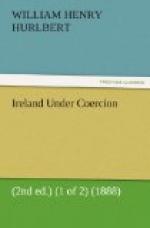Everything about Ballyconnell House is out of key with the actual military conditions of life here. It is essentially what Tennyson calls “an ancient home of ordered peace.” In the ample hall hang old portraits and trophies of the chase. The large and handsome library, panelled in rich dark wood, is filled full of well-bound books. Prints, busts, the thousand and one things of “bigotry and virtue” which mark the dwelling-place of educated and thoughtful people are to be seen on every side. Mr. Olphert showed us a cabinet full of bronzes, picked up on the strand of the sea. Among these were brooches, pins, clasps, buckles, two very fine bronze swords, and a pair of bronze links engraved with distinctly Masonic emblems, such as the level, the square, and the compasses. When were these things made, and by what people?
So far as I know, Masonry in the British Islands cannot be historically traced back much, if at all, beyond the Revolution of 1688.
Mr. Olphert and his son walked about the place with us. They have no fears of an attack, but think it wise to keep a force of police on the premises. The only demonstration yet made of any kind against the house was the march from Falcarragh some time ago of a mob of young men, who promptly withdrew on catching sight of half-a-dozen policemen within the park gates. As to getting his work done, some of his people had steadily refused to acknowledge the “boycott,” and they were now strengthened by the attitude of those who had surrendered to the pressure, and were now sullen and angry with the League which had given them nothing to do, and no supplies.
At Falcarragh we met a person who knew much about the late Lord Leitrim, who was murdered in this neighbourhood on the highway some years ago. He spoke freely of the murderer by name, as if it were matter of common notoriety. Of the murdered man, he said that he had made himself extremely unpopular and odious, not so much by certain immoralities freely alleged at the time of his death, as by vexatious meddling with the prejudices and whims of his tenants. “He used to go into the houses and pull down cartoons and placards, if he saw them put up on the walls.” “No! he had no party feeling in the matter; he used to pull down William III. and the Pope with an equal hand.” It seems that in this region, too, a local legend has grown up of the birth at a place called Cashelmore of a “Queen of France.” The case is worth noting as throwing light on the genesis and accuracy of local traditions. The “Queen of France” referred to proves, on inquiry, to have been Miss Patterson, who married Jerome Bonaparte, brother of the first Emperor, afterwards created by him King of Westphalia! This Avas the lady so well known in America as Mrs. Patterson Bonaparte of Baltimore, who died at a great age only a few years ago. I have no reason to suppose that she was born at Cashelmore at all or in Ireland. But her father, reputed in the time of Washington to be the richest man in the United States, who came from the North of Ireland and settled in Baltimore as a merchant, may very well have been born there.




